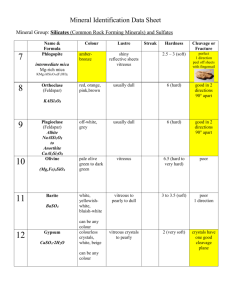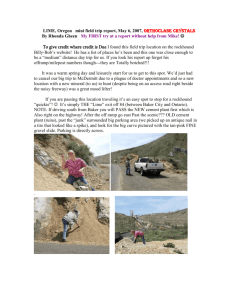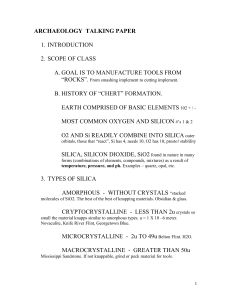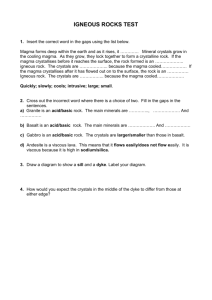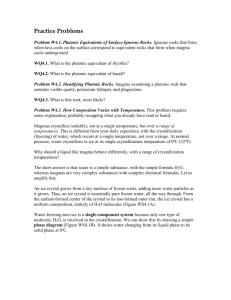Classification & Description of Igneous Rocks
advertisement
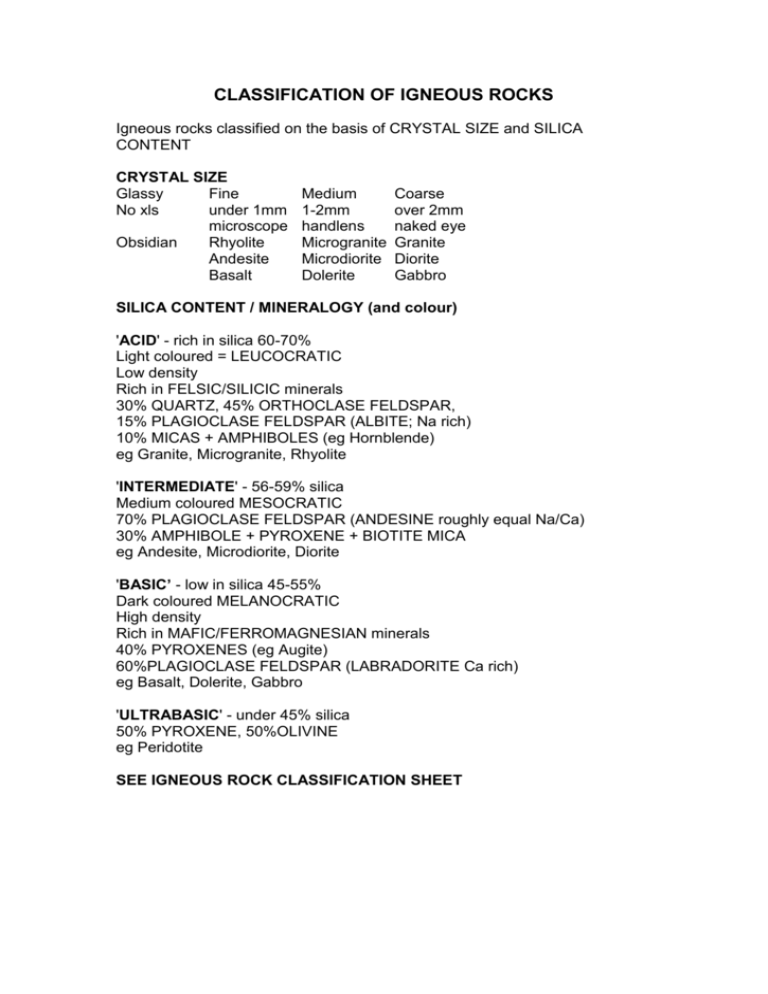
CLASSIFICATION OF IGNEOUS ROCKS Igneous rocks classified on the basis of CRYSTAL SIZE and SILICA CONTENT CRYSTAL SIZE Glassy Fine No xls under 1mm microscope Obsidian Rhyolite Andesite Basalt Medium 1-2mm handlens Microgranite Microdiorite Dolerite Coarse over 2mm naked eye Granite Diorite Gabbro SILICA CONTENT / MINERALOGY (and colour) 'ACID' - rich in silica 60-70% Light coloured = LEUCOCRATIC Low density Rich in FELSIC/SILICIC minerals 30% QUARTZ, 45% ORTHOCLASE FELDSPAR, 15% PLAGIOCLASE FELDSPAR (ALBITE; Na rich) 10% MICAS + AMPHIBOLES (eg Hornblende) eg Granite, Microgranite, Rhyolite 'INTERMEDIATE' - 56-59% silica Medium coloured MESOCRATIC 70% PLAGIOCLASE FELDSPAR (ANDESINE roughly equal Na/Ca) 30% AMPHIBOLE + PYROXENE + BIOTITE MICA eg Andesite, Microdiorite, Diorite 'BASIC’ - low in silica 45-55% Dark coloured MELANOCRATIC High density Rich in MAFIC/FERROMAGNESIAN minerals 40% PYROXENES (eg Augite) 60%PLAGIOCLASE FELDSPAR (LABRADORITE Ca rich) eg Basalt, Dolerite, Gabbro 'ULTRABASIC' - under 45% silica 50% PYROXENE, 50%OLIVINE eg Peridotite SEE IGNEOUS ROCK CLASSIFICATION SHEET IGNEOUS ROCK TEXTURES V fast cooling of acidic magma: no crystals form: GLASSY texture eg OBSIDIAN Glass altered by DEVITRIFICATION has a SPHERULITIC texture eg 'SNOWFLAKE OBSIDIAN', often with curving cracks or PERLITIC TEXTURE Fast cooling eg lava at surface, small/shallow intrusions - finely crystalline, poorly formed = ANHEDRAL Slow cooling eg large pluton/batholith intrusions - coarsely crystalline, well formed = EUHEDRAL Uninterrupted, steady cooling - EQUIGRANULAR texture Interrupted ie 2 stage cooling eg a) migration of magma from pluton to dyke/sill b) eruption from magma chamber to surface PORPHYRITIC texture - large, usually euhedral PHENOCRYSTS: slow cooling of large magma body at depth - fine GROUNDMASS: faster cooling in smaller/shallower magma body or at surface INTERGROWTH TEXTURES GRAPHIC - intergrowth of quartz and orthoclase feldspar, probably the result of crystallisation of acidic magma at or near to the eutectic point (looks like angular writing) GRANOPHYRIC - small scale graphic texture POIKILITIC- small crystals enclosed in larger ones eg small crystals of olivine enclosed in larger amphiboles OPHITIC - small euhedral plagioclase feldspar crystals enclosed by large pyroxenes; common in dolerites REACTION TEXTURES ZONED CRYSTALS - Common in plagioclase feldspars; Ca rich core, Na rich rim due to d cooling preventing completion of reaction of early formed crystal with melt CORONA STRUCTURE - Olivine core surrounded by Pyroxene, surrounded by Amphibole; formed by reaction of early formed crystals with melt LAVA TEXTURES VESICULAR - bubbles caused by gas coming out of solution due to release of pressure when lava is erupted; may be elongated in direction of flow AMYGDALOIDAL - vesicles infilled with minerals eg calcite, quartz, agate DESCRIBING IGNEOUS ROCKS THE OUTCROP 1 Location and general form of outcrop; sketch if appropriate 2 Orientation and spacing of joints 3 Relationship with veins, dykes, sills; apply law of cross cutting relationships 4 Nature of contact with surrounding rocks THE HAND SPECIMEN 1 Weathered surface; texture, colour eg rusty indicates oxidation of iron rich pyroxenes and olivines in basic rocks 2 Collect representative samples ie average and variations 3 Colour of fresh surface; Leucocratic/ Mesocratic/ Melanocratic 4 Relative density 5 Use HANDLENS + GRAINSIZE CARD (or ruler!) to observe and record TEXTURE (SIZE/ SHAPE/ARRANGEMENT of crystals) a) crystal size (in mm as well as glassy/ fine/ medium/ coarse) b) crystal shape (euhedral / anhedral) c) Crystal arrangement (equigranular/ porphyritic/ flow banded) d) Presence of vesicles/ amygadales 6 Estimate number and proportions of different minerals present Record mineral colour, cleavage, lustre, crystal shape,hardness where possible Suggest identification of minerals based on observations/tests FELSIC MINERALS QUARTZ; colourless/grey, no cleavage, vitreous lustre, usually anhedral, harder than 5.5 ORTHOCLASE FELDSPAR; orange/pink, 2 poor cleavages at 90', dull/vitreous lustre, rectangular 'lath' shaped crystals (may show simple twinning) harder than 5.5 PLAGIOCLASE FELDSPAR; white/grey, 2 poor cleavages at 90', dull/vitreous lustre, rectangular 'lath' shaped crystals (May show multiple twinning), harder than 5.5 MUSCOVITE MICA; white/silver, 1 perfect cleavage (flakes), vitreous lustre, tabular crystals, hardness >2.5 <3.5 MAFIC MINERALS Very difficult to identify with certainty! PYROXENE; black anhedral crystals AMPHIBOLE; greenish black (not as dark as pyroxene) anhedral crystals OLIVINE; olive green, poor cleavage, vitreous lustre, anhedral crystals, harder than 5.5 BIOTITE MICA; black/brown, 1 perfect cleavage (flakes), vitreous lustre, tabular crystals, hardness >2.5 <3.5 ESTA GEOTREX The Geology Teachers Resource Exchange Contributor: Ben Church Establishment: Monmouth Comprehensive School Date:24:05:05

